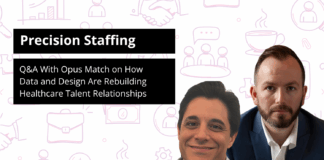
The pandemic may have tested the optimism of global staffing and recruitment leaders, but it emphasized what many already knew — future success depends on technological innovation.
Bullhorn recently surveyed more than 800 global staffing professionals to find out what changes the pandemic brought to the industry. We spoke with Vinda Souza, Bullhorn’s Vice President of Global Communications, to learn more about the results of the COVID-19 Impact Survey and how businesses are fostering resilience in the new normal.
Shifting priorities in staffing
Bullhorn’s survey found that the #1 priority among staffing firms is improving the management of client relationships, with improving candidate experience a close second.
Souza attributes this shift to the current recession. “When you’re in a recession,” she notes, “you favor clients because you have a lot of demand and unemployment is high.” Staffing firms are more likely to prioritize candidate relationships when business is booming, and companies need more skilled labor.
Impacts on business and employees
As part of an effort to keep business afloat during challenging times, 36% of respondents added controlling spend to their top priorities. Twenty-eight percent of respondents said their bottom line fell by 30% or more. However, another handful of companies (30%) reported that their business performance was as good as or better than last year’s.
Staffing sectors that have struggled the most included hospitality and travel (45% with a bottom line down by at least 30%), office and clerical, and marketing and creative. But some amount of loss impacted even the highest-performing sectors, like healthcare and IT/technical.
Loss in business also correlated with a reduction in internal employees. Nearly half of staffing companies had to cut back on employees, especially within temporary/contract agencies and larger companies.
Winning with temporary labor
The pandemic quickly shifted perspectives on temporary labor. In terms of business performance, temporary staffing agencies have fared much better than permanent agencies in recent months.
The flexibility and agility that temporary staffing offers is more important in times of uncertainty, as companies across industries are letting go of permanent employees and changing the way they work.
“We had a big debate years ago around gig economy platforms and how they fit in the staffing ecosystem,” Souza says. “Are they threatening, or are they additive? It’s hard to say, but the bottom line is you better be cognizant of how you fit into an ecosystem where these types of platforms exist.”
Embracing remote work
The majority of respondents believe remote work is here to stay, and they’re planning for that future — 34% added optimizing remote work to their priorities this year. Many firms (64%) expect remote jobs to become more common, and they plan to recruit (57%) and onboard (41%) candidates remotely.
Souza says two schools of thought have emerged as operations shifted to remote work — the side that feels the risks are worth returning to the office, and the side that would rather not take those risks and has grown comfortable working off-site. “There’s a sizable chunk of leaders who realize, ‘I don’t need to be in the office. It turns out, my productivity and efficiency can be pretty high with a remote distributed workforce.’”
Remote work also removes barriers like geographical locations tied to open positions. “Not only are customers of the staffing agencies realizing that they can hire people from anywhere,” Souza says, “but I think they themselves are realizing they don’t really need to be tethered to one spot.”
The leaders who welcomed remote work have the technology, software, and tools in place to make it successful. And, of course, this model only works for non-essential positions. Jobs that require employees to be on-site have a different set of challenges to navigate to keep employees safe.
Building relationships in a contactless world
How will the work-from-home trend impact those relationship-building in staffing?
“Relationships will always be the primary currency of recruiting,” Souza explains. “But many of the strategies we’ve come to romanticize — the handshake, the wining and dining, the lunches, the close meetings, flying around the country — don’t work anymore. They may never work again.”
Given that many firms are running short on employees themselves, they’ve become more reliant on automation technology to cultivate relationships. “We’ve seen a dramatic demand for our Herefish candidate experience solution,” Souza says. “People don’t want to be bogged down with the complex process of nurturing a candidate relationship, especially if you can’t see them face-to-face or interact with them.”
Virtual interviews and conferencing are also becoming the norm — 91% of respondents said they’re using this technology more since the start of COVID-19.
Other increasingly adopted technologies related to communication and relationship-building include VoIP (25%) and SMS (24%).
Future-proofing with digital transformation
Regardless of their business performance, most respondents predicted an economic improvement on the horizon. Thirty-three percent said they expect that improvement by the end of the year. “And they’re right,” Souza says, “in the United States, at least.”
Although there’s evidence of economic recovery, the pandemic situation has yet to improve. Some areas have been more successful at handling outbreaks than others, but returning to normal depends on vaccine development and distribution. Unfortunately, that won’t happen overnight, and it won’t be without complications. But this fact isn’t stopping staffing firms from adopting a positive outlook.
Businesses become optimistic when they’re prepared for whatever the future may hold, when they have a safety net to fall back on in tough times. “Digital transformation is that safety net,” Souza says.
Digital technologies eliminate risks and automate mundane tasks like data collection, onboarding, and payments. Souza believes unified workforce management — a system that centralized all aspects of the recruiting and hiring process — is the answer to future-proofing staffing.
“If you want a cohesive workflow, especially amidst a distributed workforce, then you need an organized system where the truth is the truth, and you have a single version of it. Otherwise, you’re just going to be creating a tremendous amount of risk and mess. And that’s a level of inefficiency that no one needs in their business, especially not right now.”
Even though there’s no end in sight for COVID-19, Souza believes the time is now for investing in digital transformation. “You can drive the beat-up old jalopy for another couple of years, probably,” she says. “But when it fails, it’s going to fail badly. And you’re going to wish you had bought a nice car with computer technology and all-wheel drive.”
For more on the importance of the digital transformation in late 2020 and beyond, check out our 2020 State of Staffing webinar.





